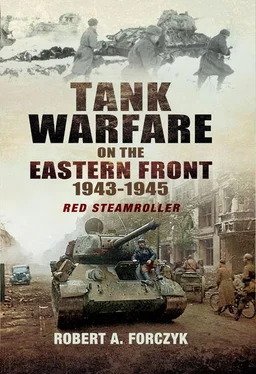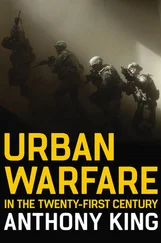Allied strategic bombing also had some effect on German tank production, although Alkett was the only factory that was seriously disrupted in 1943. Panther production was temporarily reduced in August 1943 when the MAN plant was bombed twice. {32} The Henschel plant in Kassel was bombed by the RAF in October 1943 and also suffered some disruption in Tiger tank production. {33} In November 1943, a major RAF raid on Berlin left much of Alkett’s Berlin-Borsigwalde plant in ruins, which severely disrupted StuG III production for about six weeks. Reacting hastily, Hitler decided in December 1943 to terminate Pz IV production at the Krupp-Grusonwerk AG plant and instead use Pz IV hulls to build the new Jagdpanzer IV assault gun. Guderian opposed this decision, pointing out that Alkett would soon restore StuG III production and that Hitler had already authorized a new tank destroyer to be built on the Panther hull (the Jagdpanther), armed with an 8.8cm Pak 43. It made little sense for Germany to further reduce its tank output in order to produce another assault gun variant, but again he was ignored.
The RAF bombing of the Ruhr in March–June 1943 also caused the Zulieferungskrise (sub-component crisis) in which delays in the arrival of sub-components delayed AFV construction at the main plants. {34} For example, a Pz IV assembled at the Nibelungenwerke received its turret from Magdeburg, its main gun from Dusseldorf, its engine from Friedrichshafen and various other sub-components from across the Reich. Allied bombing increasingly disrupted rail yards in central Germany, causing delay in the internal transport network. Without a large stockpile of critical sub-components on hand, the main tank plants became increasingly vulnerable to transportation disruptions. Allied bombing also induced second-and third-ordered effects, by causing distribution problems with raw materials and damaging the myriad of small manufacturers who built unique items for tanks.
The Red Army’s Tank Forces
In 1943, the Red Army had six different kinds of armoured units with a variety of missions committed on the Eastern Front:
• Tank Armies, intended to be capable of large-scale mobile operations. Although the Red Army had created five tank armies in 1942, both the 1st and 4th Tank Armies were disbanded after suffering crippling combat losses in August 1942. At the start of 1943, the 2nd, 3rd and 5th Tank Armies were still active. These formations were supposed to consist of two tank corps and one mechanized corps with about 500 tanks, but the tank armies were still rather improvised in nature.
• Tank Corps (consisting of three tank brigades and a motorized rifle brigade), were intended for either independent mobile operations or as part of a larger Tank Army. As defined by Stalin’s Order No.325 in October, the primary purpose of the Soviet Tank Corps was to destroy enemy infantry, not fight enemy tank formations. At authorized strength, the Corps should have 159 tanks (96 T-34 and 63 T-70) in six tank battalions and 3,200 infantry in six motorized infantry battalions and one motorcycle battalion. However, fire support was limited to a single Guards Mortar Battalion with eight BM-13 multiple rocket launchers, which was a serious deficiency.
• Mechanized Corps (consisting of three mechanized brigades and usually a tank brigade or two tank regiments) were intended to act primarily as a breakthrough and pursuit force for the front-level commander. A full-strength mechanized corps should have 170–200 tanks in five tank regiments and almost 6,000 motorized infantrymen in nine battalions. The mechanized corps had additional fire support that the tank corps lacked, including three light artillery battalions (each with 12 76.2mm guns) and additional mortars. However, the mechanized corps was critically short of trucks to move its infantry brigades and was forced to mount a good portion of its infantry on tanks. By late 1944, the arrival of large numbers of Lend-Lease trucks would alleviate this shortage and greatly enhance the mobility of Soviet mechanized corps. {35}
• Tank Brigades (consisting of two tank battalions and a motorized rifle battalion), were the basic building-block of Soviet manoeuvre warfare. For most of 1943, a tank brigade was authorized 32 T-34 medium tanks and 21 T-70 light tanks (or Lend-Lease equivalents). A medium tank battalion was usually led by a Kapetan or Major and had two tank companies, each with 10 T-34 tanks, plus one for the commander. In terms of support, the tank battalion was authorized a 27-man supply platoon, which was supposed to have 13 trucks (including three for fuel and two for ammunition). {36} The brigade had only modest reconnaissance capability (a scout platoon with three armoured cars) and no fire support – it was not a combined arms team but rather a tank-heavy formation. Consequently, Soviet Tank Brigades were best used as sub-components in a larger formation, but they could and did serve as independent infantry support units as well. By 1943, the trend was increasingly to incorporate tank brigades into larger formations in order to maximize their shock power.
• Tank Regiments were separate formations used in either the breakthrough or infantry support role, and often equipped with heavy tanks. In January 1943 the tank regiment consisted of either 32 T-34 and seven T-70 or 21 KV-series heavy tanks. Unlike the tank brigade, the tank regiment had no organic infantry component and its armour was usually employed as individual companies, not battalions. {37} Most of the KV-series tanks were being assigned to newly-formed Guards Heavy Tank Regiments.
• Independent Tank Battalions (OTB) were usually separate formations tasked with the infantry support role. The OTBs were extremely heterogeneous in composition and could include up to five KV-series heavy tanks, 11 T-34s or equivalent Lend-Lease tanks and 20 light tanks. A few OTBs were equipped with flamethrower tanks or captured German tanks. A full-strength OTB had 36 tanks, but these units tended to stay at the front for long periods of time and typical strength was more like 10–20, with some reduced to just a handful of operational tanks. {38} By 1943, these units were being phased out since they were a relic of the improvisation days of 1941.
On 1 January 1943, the Red Army had a total of 20 tank Corps, 11 Mechanized Corps, 120 tank brigades, 91 tank regiments and 68 OTBs. According to Krivosheev’s data, at that time the Red Army had 20,600 tanks on hand, of which 7,600 were medium tanks (T-34 or M3 Grant) and 2,000 were KV-series heavy tanks. The remaining 11,000 tanks were light T-60s and T-70s or Lend-Lease Matildas, Valentines, Lees and Stuarts. {39} A small number of American M4A2 Shermans had arrived via the Persian Corridor in late 1942, but were just beginning to be fielded. Some of the Soviet armoured units that had been heavily engaged in the December 1942 fighting, such as the 24th and 25th Tank Corps, had very few tanks operational, but most Soviet tank units had at least 50 per cent of their tanks operational. Unlike the Germans, the Red Army did not divert sizeable amounts of armour to quiet fronts; in 1943 there were some 2,500 tanks (mostly obsolete T-26 and BT-7 light tanks) deployed in the Far East and a few hundred on the Turkish-Iranian borders. The Stavka’s Reserve (RVGK) contained two tank corps, four tank brigades, three tank regiments and three OTBs, amounting to about 700 tanks. In addition, there were over 2,000 tanks in the Moscow, Volga and Trans-Baykal Military Districts. This left approximately 14,000 Soviet tanks at or near the front, with perhaps 7–8,000 operational. This meant that the roughly 1,000 operational German tanks and assault guns on the Eastern Front were outnumbered by more than 7:1, which far exceeded the textbook 3:1 numerical advantage required for a successful attack.
Читать дальше








![John Stieber - Against the Odds - Survival on the Russian Front 1944-1945 [2nd Edition]](/books/405234/john-stieber-against-the-odds-survival-on-the-russian-front-1944-1945-2nd-edition-thumb.webp)



